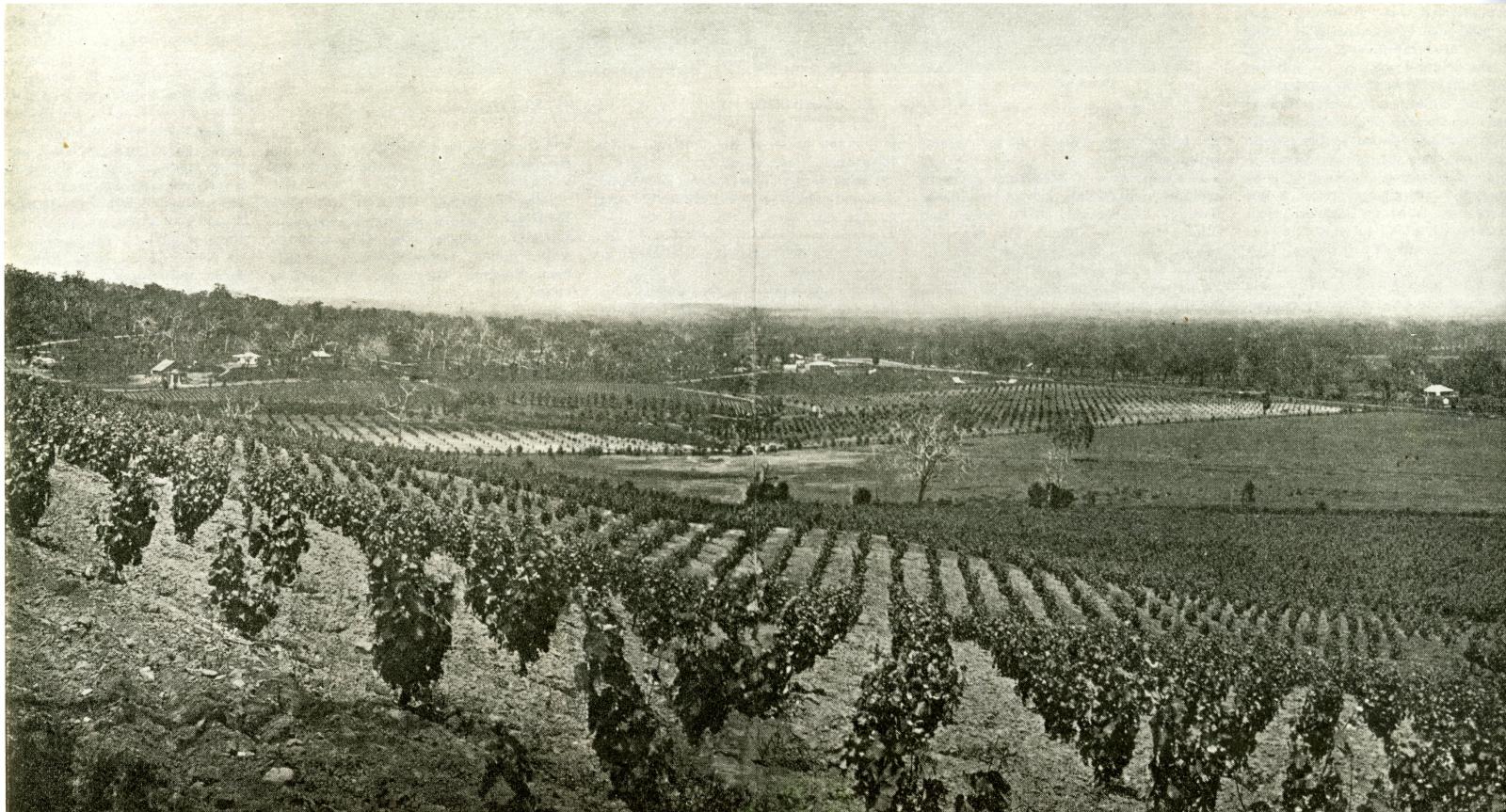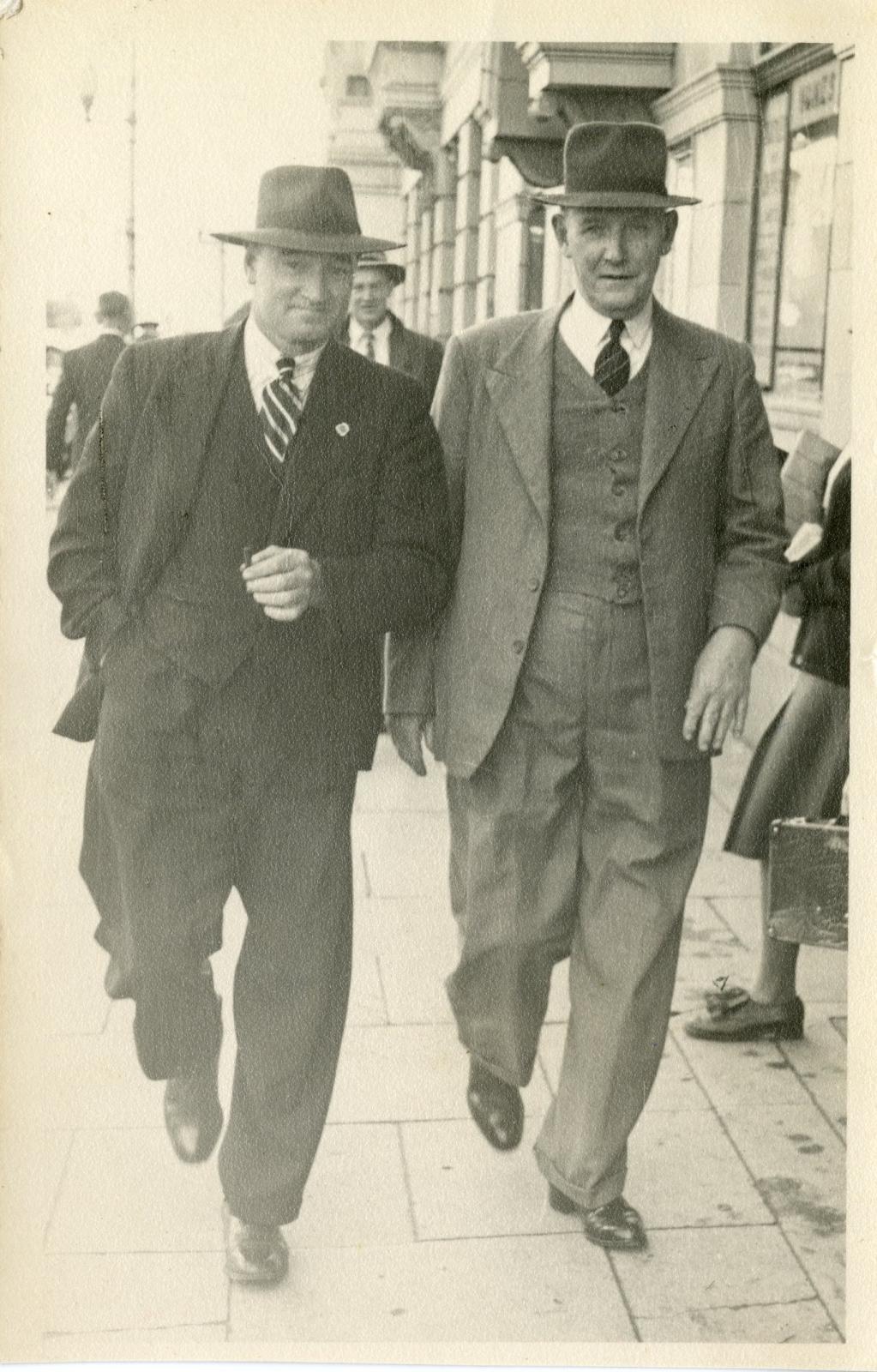Wine making in the City of Armadale
City of Armadale - History House
Vines have been cultivated and turned into wine for over 7,000 years. So it was not surprising that as European ships travelled across the world they took vine cuttings and bottles of wine with them. When the First Fleet arrived in Australia in 1788 they had on board vine cuttings and soon a number of vineyards were established around Sydney. In Western Australia vines were quickly planted in the Swan Valley, yet it was not till 1859 that the first vintage for commercial sale was produced.
In the Armadale region viticulture arrived in the 1890’s. Since the first vine was planted, wine has been made regularly in Armadale. Martin Jull and Dr Ferguson Stewart were the founders of the local commercial wine making industry. Previous to this there were a couple of properties with a few vines on them. In 1894 they planted 26 hectares of vines on the slopes of the Darling Ranges overlooking the Narrogin Inn and the road to Perth. Their aim was to produce port and red wine, so Jull planted Shiraz and Grenache vines along with Malbec and Cabernet Sauvignon vines. Not long after Jull and Stewart planted their first vines, Mr C. S. Tratman started growing grapes as did Edward Marsh at Paradise Farm, which was further up the hill on the road to Albany. Neither Marsh nor Tratman lasted very long in the business. In 1899 Thomas James, who had married into the Marsh family, started a vineyard at Mt Paradise, just down the road from Paradise Farm. The vineyard operated until 1912.

Derry Na Sura Vineyard with the town of Armadale in the background, c1912 FPH43, Birtwistle Local Studies Library
Derry Na Sura Vineyard
The Jull Stewart vineyard grew and soon drew the attention of Sir Arthur Stepney. Stepney was a wealthy English Baronet who travelled around the world seeking business opportunities. In the late 1890s he purchased Dr Stewarts share of the vineyard, employed a manager,and invested in expanding the vineyard to over 68 hectares as well as building a three story wine cellar. Increasing work demands convinced Martin Jull in 1904 to sell his share of the vineyard to Stepney. By 1905 he had named the vineyard Derry Na Sura. Just prior to his death in 1909, Stepney sold Derry Na Sura to Mr Sewell and Crocker who employed Harry Ullman to manage the vineyard.

A banquet being held in the Derry Na Sura cellars, c1906 PH111, Birtwistle Local Studies Library
Harry Ullaman spent nineteen years managing Derry Na Sura, increasing production from 86,376 litres of wine in 1910 to 136,383 litres in 1928. The wine was sold overseas and in Perth. Ullman and later managers, including C. E. Pyke, kept a close eye on the quality of the wine being produced. Derry Na Sura ports and red wines won numerous Perth Royal Show awards during the 1920s and 1930s. The Great Depression (1929-32), followed by World War Two hit the vineyard hard. Sales dropped, labour was hard to find, the vines were getting old and the cost of rehabilitating the property was deemed too high. In 1951 the land was sold to Mick Mouritz who cleared away the vines to make way for grazing. This only lasted a few years before he subdivided the land and sold for housing. Today the land is the suburb of Mt Nasura.

Mr C.E. Pike, manager of Derry Na Sura Vineyard Ltd. walking with company secretary Mr MacWilliams, 1938. PH114, Birtwistle Local Studies Library
Slavonian / Richon Vineyard
In the early 1900s Joseph Marion and his nephew Anton purchased land along the Bunbury Road just south of Armadale. Joseph and Anton were born on the island of Hvar of the coast of Croatia. Joseph arrived in Western Australia, via Victoria in the 1890s with Anton joining him in 1901. They originally worked as farmers, only planting a couple of hectares of vines. In 1905 they produced their first vintage. The following year they built a cellar, expanded the vineyard and the property became known as Slavonian Vineyard. They mainly produced wine, which was originally sold to Eastern European timber cutters working in the area. By 1913 they were producing around 36,370 litres of wine and selling barrels of wine to licensed venues in the Eastern Goldfields as well as venues around Perth. Joseph passed away in 1914 leaving Anton to run the vineyard.
In 1920 Anton sold the property to Mr Gerald McCarthy. McCarthy renamed the vineyard Richon, after the wine producing town of Richon le Zion in modern day Israel, near where he had been stationed during World War One. McCarthy ran the vineyard until 1955, when he sold the vineyard and it was cleared for farming. In 1989 the cellars were demolished and a few years later the land was subdivided for housing and is now a part of the suburb of Mt Richon.

Richon Vineyard, c1924. The long white building single story building in the background is the vineyard's cellar. MPH26, Birtwistle Local Studies Library
Local Vineyards
From the 1920s to the 1960s, several smaller vineyards operated around Armadale.
Opposite Derry Na Sura, the Tognolini family produced casks of wine, fortified wine, table grapes and dried currants. The wine was made by Marion who after the death of her husband Joseph ran the vineyard from the late 1920s to when it was sold in the 1950s.
North of Byford on the Bunbury Road was Sunray Vineyard which was run by the Vlasich family from the late 1930s till it was sold around 1964. Sunray Vineyard also sold casks of wine and fortified wine from the cellar door. A sign on the side of the road attracted considerable passing trade. Paul Vlasich, who with his father Marin had started the vineyard, also spent time as the one of the last managers of Derry Na sura from 1947-49.
On the western side of the railway opposite the station the Bavich family ran a small vineyard. To avoid the need for a license they only sold table wine. A license was necessary for making the stronger fortified wines like port and sherry.
In the 1990s Willowsping Winery opened its doors in Bedfordale but used fruit instead of grapes to make the wine.
In 2006 Rocksgate Winery in Bedfordale opened its doors and grew Merlot, Shiraz and Cabernet grapes, ensuring the continuation of the wine making industry in the City of Armadale.
The Sikes hydrometer was used to measure the alcoholic content of wine during the fermentation process. As the wine was fermenting samples would be regularly taken and the hydrometer would be used to measure the specific gravity of the sample. Weights would be placed on the stem of the hydrometer to keep it stable. As the sugar was converted to alcohol the samples would become less dense and the hydrometer would descend deeper into sample. When the sample result were the same 3 days in a row it meant the fermentation process was complete. The difference between the first and last measurements would be used to calculate the alcohol content of the wine.
As wine testing equipment improved, glass hydrometers were used at the vineyard. These included the standard hydrometer like the Sikes hydrometer, the acidometer for testing the relative density of a wine and the alcometer, used to determine the volume of alcohol in the wine after fermentation.
The Ebullioscope determines the alcoholic content of wine by heating it. Water is boiled first to observe its boiling point to compare against the wine sample. The sample of wine would be boiled next, the higher the alcoholic content of the wine the lower the boiling point.
Graduated cylinders were used in measuring precise volumes of liquid being added to the wine and in testing of wine during and after the fermentation process.
The Conical Flask is used to hold liquids and solids to make solutions. They could be heated to make sure the solids were properly dissolved.
Thermometers are an important part to the wine making process as changes in temperature could spoil a batch of wine during fermentation and ruin the flavour that the vigneron was wanting to achieve.
The volumetric flask is specially designed for making solutions at precise volumes at certain temperatures. Solutions added to wine would be prepared in a volumetric flask as a precise solution or dilution.
The spirit burner was a portable source of heat used to heat up samples for testing. It could also be used to sterilize some equipment before testing to prevent contamination.
Sherry film yeast “Flor” is a yeast found naturally in southern Spain. It is used in the fermentation of many types of sherry. The yeast is used to help the fermentation process by converting the natural sugars into alcohol and creating a waxy film protecting the sherry from being exposed to the air and ruining it.
The wine clarifier was used to remove solid materials from batches of wine before bottling. The vigneron would pour the wine needing clarifying into the top cylinder of the clarifier. The wine then moves to the second and larger cylinder ready to be refiltered or bottled through a tap, whilst any material remaining in the first cylinder is removed and washed.